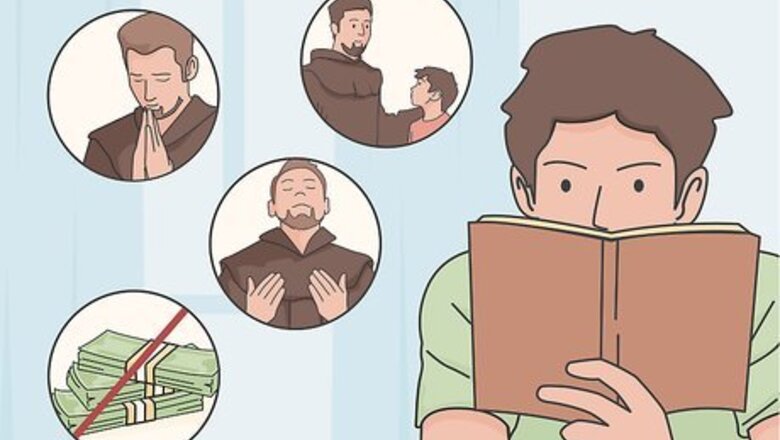
views
Becoming a Christian Monk

Learn about the 4 monastic traditions. Catholic and Anglican monasteries typically follow the same 4 monastic traditions: poverty, chastity, obedience and stability. By living and embodying these 4 traditions, Christian monks hope to grow closer to God. Christian monks work daily at the monastery, study the Bible, pray, and spend time socializing together. Nothing at a Christian monastery is done in isolation, and every day is spent in service to the monastic community.Tip: The monastery’s main goal is not to serve a lay community. The idea is that living in a monastery brings you closer to God by tying you to a community that you can’t stray from. The 4 monastic traditions guide the structure and the behavior of life in a monastery. Monks do not possess money (poverty), engage in physically-intimate behavior (chastity), disobey their superiors or God (obedience), or do anything to disrupt the community (stability). Christian monasteries are typically Catholic, Anglican, or Lutheran. There are very few protestant monasteries.

Visit a few monasteries to see which one you connect to. Due to the fact that monks at a monastery spend every day together, and the fact that every monastery has different procedures, it’s extremely important that you find a monastery that fits you. If you are called to monastic life, start visiting monasteries as a lay person. Every Christian monastery accepts visitors. Contact a monastery, let them know that you’re considering monastic life before visiting for a day or two. You should feel called to serve at a monastery. Don’t force yourself to fall in love with a monastery if it isn’t right for you. When visiting, feel free to ask questions about what life is like there. Most lay people are extremely interested in monastic life and the monks won’t mind answering your questions.

Ask the abbot or bishop what the requirements are to join. Once you feel drawn to a monastery, ask the abbot or bishop what the requirements for joining their order are. Every monastery has unique requirements, but generally speaking, you must be a member of a church, male, free of debt, and under a certain age (usually 35 or 45). Applicants younger than 21 are rarely accepted. If you’re under 18 and a monastery will let you join, it requires parental permission. Unfortunately, there are very few monasteries that allow women to join. If you’re a woman interested in monastic life, look for a convent or nunnery. The abbot is the person in charge of a monastery. However, there may be a bishop in charge of the monastery if you’re Catholic.

Interview with the abbot or bishop and submit your documentation. Fill out an application if there is one and submit letters of recommendation and any other required documents. Sit down with the abbot for your interview. In the interview, you’ll answer questions about your experience with God, your beliefs, and your reasons for wanting to join a monastery. Your letters of recommendation should speak to your religiousness and your ability to follow directions. You may need to submit medical records or previous employment information. Applications to join a monastery are rarely completed on paper. They’re often interviews with the abbot or several monks. The process is commonly referred to as an application, though.
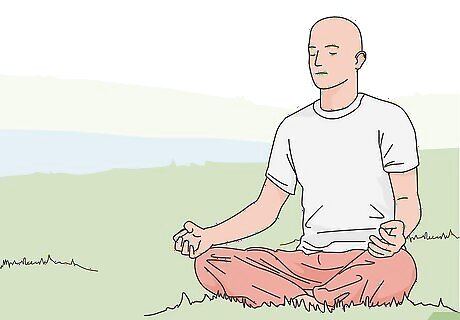
Begin the process of discernment by praying and meditating. If your application is accepted, you still have some work to do. Once accepted, you enter a period called discernment. Discernment lasts anywhere from a few days to a year. In discernment, pray for guidance and meditate on monastic life every day. The aim of discernment is to determine whether or not you really want to dedicate yourself to a monastery, so ask yourself every day if this lifestyle is right for you. Discernment may be completed at the monastery, at home, or a mix of both. Every monastery is different. During discernment, you will have interviews with the abbot. They will ask you about your prayers, thoughts, feelings, and journey in faith as you determine whether or not this lifestyle is meant for you.
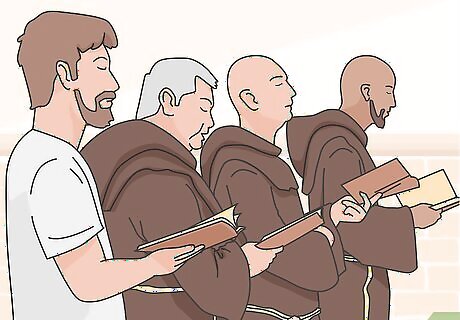
Enter observation to see if you’re a fit for the monastery. If you complete discernment, pass the interviews, and are still interested in monastic life, the abbot may invite you for observation. Observation is an official trial period where you join the monastery for 5-30 days. The other monks will assess whether you fit there, can follow the rules, understand the gospel, and are a good fit for the monastery. Observation is sort of like shadowing a school to see if it’s a good fit. You aren’t actually moving into the monastery though, so don’t break your lease or anything quite yet. In observation, you will do everything that the monks do. Do your best to follow directions, be honest, and participate in activities.
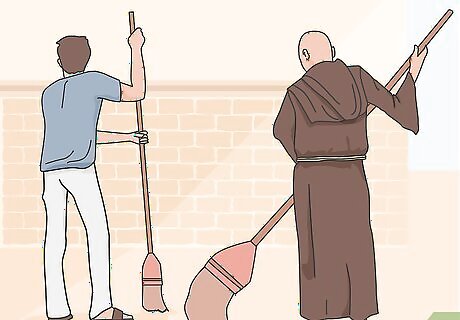
Become a postulate or novitiate for 1-5 years. If observation goes well, you will be ordained as a postulate, which is a type of student. Postulates study the ways of monastic life and complete basic tasks for the monastery, like cleaning, cooking, and helping the abbot. Once you’ve served as a postulate for some time, you will be promoted to a novitiate, which is a new monk in training. You will be given a short period of time to give up your apartment, donate or give away your possessions, settle debts, and close any accounts before starting as a postulate. You are not typically allowed to bring anything with you to the monastery. The time frame for going from a postulate to a monk is different for every person and monastery. You may spend 6 months as a postulate, or it may be 5 years before you become a novitiate. Some orders don’t have a novitiate position and simply ordain you as a monk.
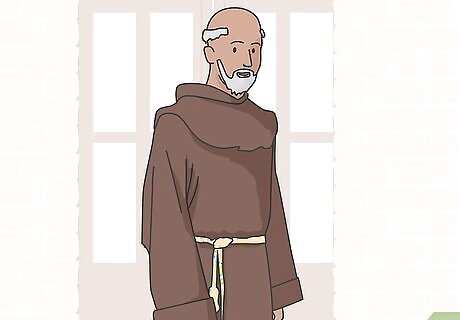
Get ordained as a monk and become a permanent monastery resident. After 1-5 years of studying, working, and praying, you will be ordained as a monk. You will be given a job at the monastery, be given more freedom, and will become a permanent resident of the monastery. Continue to pray, engage in good works, and maintain the 4 pillars of the monastic tradition. Work positions at the monastery include the chamberlain, who looks after the housing, the hosteller, who looks after visitors and guests, and the sacrist, who is in charge of finances and relics. There are dozens of different positions at a monastery.
Joining a Buddhist Vihara
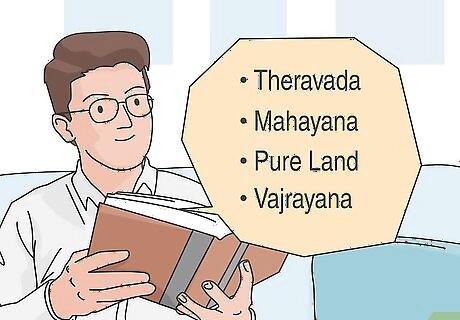
Learn about the 4 major Buddhist paths and monasteries. There are 4 major types of Buddhism alongside dozens of smaller sects and paths, each with their own monasteries, which are often called viharas. There are also “spiritual” monasteries that don’t follow a specific Buddhist path and simply work together to help each individual member grow closer to God. Some Buddhist monasteries focus on helping the lay community, while some shut themselves off from society entirely. Study the traditions to understand the possible paths. Theravada is the most orthodox form of Buddhism and focuses on the original teachings of Buddha. Mahayana is a more flexible form of Buddhism. It treats many of the Buddhist beliefs as guides rather than hard rules. Pure Land Buddhism is a popular and modernized version of Mahayana. It emphasizes a smaller set of religious texts and rebirth. Vajrayana Buddhism was developed in Tibet and the Himalayas and is what many people think of when they picture Buddhist monks. These monasteries tend to be the most isolated and private.
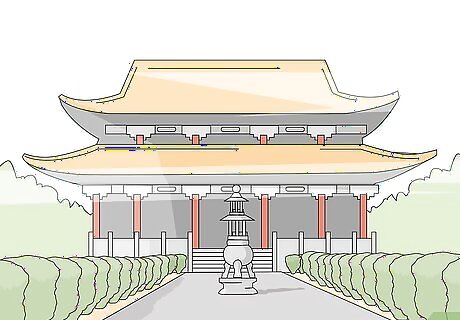
Visit and read about monasteries that align with your Buddhist beliefs. If you want to explore joining a Buddhist monastery, start by visiting monasteries in your area that align with your path. When visiting each monastery, ask for literature about their tradition and temple. Read up on each specific monastery’s practices to see if it’s a good fit for you.Tip: Since there is so much variation between temples, most Buddhist monasteries have their own presses to publish their teachings and beliefs. These texts are usually free to the public. The term monastery, temple, and vihara are interchangeable in Buddhism. Some Buddhist monasteries have missions, some have part-time monks, and some require vows of silence. There is a wide range of beliefs and requirements when it comes to Buddhist temples.
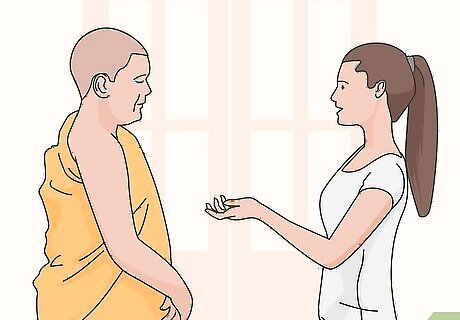
Ask about the requirements to join the monastery. Once you’ve found a monastery that you want to join, contact the abbot, head monk, or spiritual leader and ask them what it takes to join their order. Typically, you can be male or female, but must be in good health and younger than 40. In Buddhism, the term “monk” is usually used to refer to both men and women.
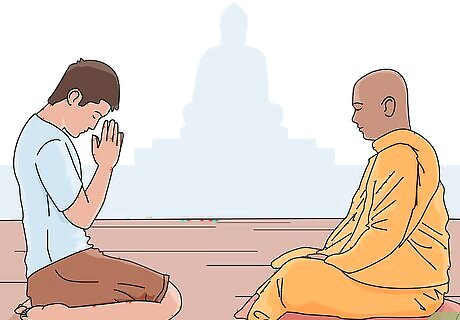
Visit the temple for an extended visit and meet with a novice master. To start the process, the monastery will ask you to come for a formal visit, usually for 5-10 days. During this period, you will be assigned a novice master—a teacher that will guide you through the process of ordination. Meet with the other monks, meditate with them, and talk to the novice master about your goals, motivation to join the monastery, and personal relationship with Buddhism. Ask the novice master about the guru. Since gurus are typically sheltered from the daily interactions with visitors, it can be difficult to get a sense for what they’re like without an insider’s perspective.
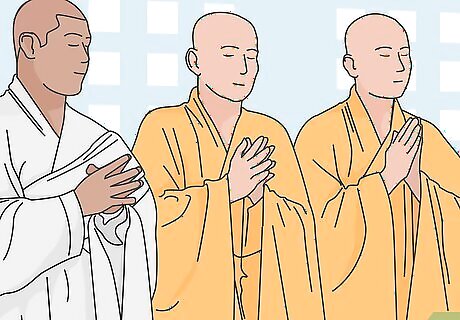
Become a postulate for 1-5 years and study the monastic way of life. If the monastery thinks you may be a good fit, you can become a postulate. Start wearing the robes required by the temple and clip your hair short. Spend the next 1 month to 5 years learning from the masters, meditating, and engaging with the other monks. Postulates and monks wear different hairstyles to indicate their rank and position. Typically, monks shave their head while postulates clip their hair short. Some postulates are required to tie their hair up as well. In Buddhism, a postulate is basically a student. You will have to follow all of the principals of monkhood. You must become celibate, give up worldly pleasures, and live a healthy lifestyle.
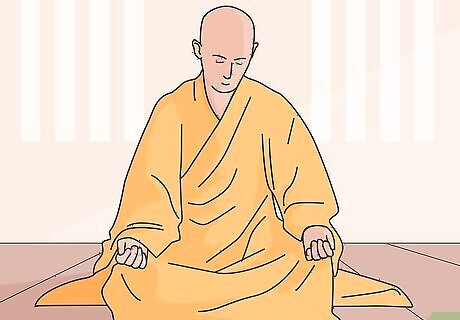
Apply for ordination to become a Buddhist monk. After your period of postulation is over, you can apply to become ordained as a monk. This process is different at every monastery, but typically requires an interview and some kind of demonstration of faith (usually in the form of a test, testimony, or sermon). Once you’ve been approved by the abbot or spiritual leader, you can begin living life as a Buddhist monk. You will be required to give up your possessions and move to the monastery permanently, although there are some paths and traditions that allow monks to maintain possession of an apartment, car, or personal belongings. Once you are a monk, you can study to become a novice master—a monk that guides other postulates.
Entering a Hindu Temple

Study the structure and diversity of Hindu monasteries. Hinduism is a polytheistic religion, meaning that they believe in multiple Gods. Each temple is dedicated to a specific God, although Hindus believe that all Gods help lead you to the path of oneness. Because there is no single path for every person, there is a ton of variety in Hindu monasteries. Some are isolated, while some focus on serving a lay community. Every monastery has different requirements, beliefs, and practices.Tip: In Hinduism, all paths are seen as equally valid since each individual has to follow their own interior beliefs on how to grow closer to God. In Hinduism, the term temple and monastery are often used interchangeably. The official name for a Hindu temple or monastery is a mandir. Many Hindu monks don’t permanently live at the temple where they’re a member.
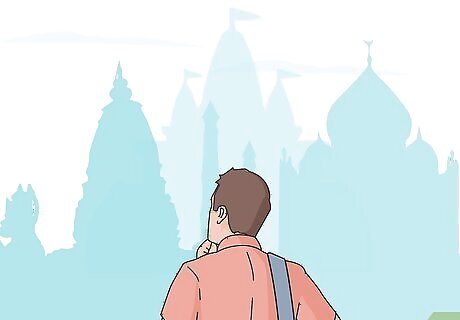
Visit temples and mediate at each one to find one that suits you. Research temples and monasteries in your vicinity. Attend them during public hours to get a sense for the space. If you feel drawn to a specific temple, order, or monastery, it may be a sign that you belong in that space. Meditate at each temple for at least 1 hour to determine whether you feel spiritually drawn to it. Most temples and monasteries have public hours—even if members of the monastery live there permanently. These are hours for visitors to come and admire the architecture, talk to religious leaders, and meditate through mantras. Follow each temple’s dharma by adhering to the social rules of the monastery. Dharma is a complex Hindu concept. It is essentially the laws and regulations that dictate conduct, and maintaining it ensures that you grow closer to God. Maintain dharma by following the monastery’s rules. Every temple and monastery has its own order. An order is essentially a religious community with a unique structure.
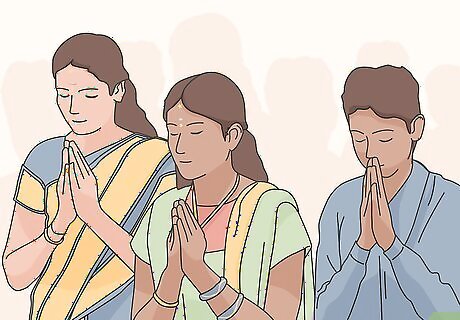
Join the order of the temple by attending pujas. Pujas are organized prayers and rituals that are completed as a community. Attend the pujas during the organized times to see the guru speak. If you are moved by the guru and feel at home in the temple, it may be a good fit for you. Fill out an application form after a puja to become a member of the community. A guru is a religious master in charge of a temple or monastery. Depending on the sect, the guru may be referred to as a sant, monk, yogi, or spiritual leader. You may need to complete an interview with a sanyāsī, sādhu, or swami (types of Hindu monks and priests) before you can become a member of the community.

Write a letter to the temple’s guru and state your intentions. To initiate the monastic process, write a letter to the guru introducing yourself. Explain your journey to their order and express your interest in becoming a monk. Drop the letter off or send it as an email. You will receive an email or letter in response inviting you to visit and meet with the other monastic members. You may be told that you need to wait at least 1-5 years before you can become a monastic member of the order.
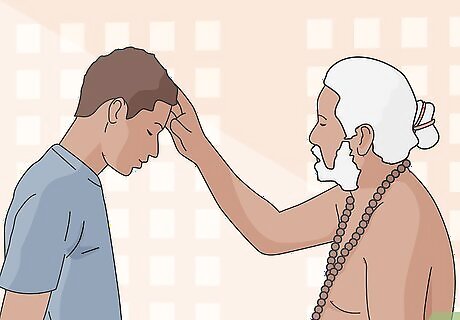
Complete any classes or interviews required to become an initiate. After meeting with the monastic members, sign up for any classes that you’re required to take. Complete any interviews with the guru or other members. Once you’ve completed the temple’s initial requirements and received blessing from the guru, you are an initiate. Buddhism has 3 major religious texts, while Christianity has 1. Hinduism, on the other hand, has 5 key texts and dozens of minor holy books. These classes will often help you understand and work through the major holy books. The classes will cover key components of your specific Hindu path. Since every Hindu discipline has different beliefs, there is a lot of variation among the material that these classes will cover. Other topics in your classes will include darshan, the concept of karma, and reincarnation.
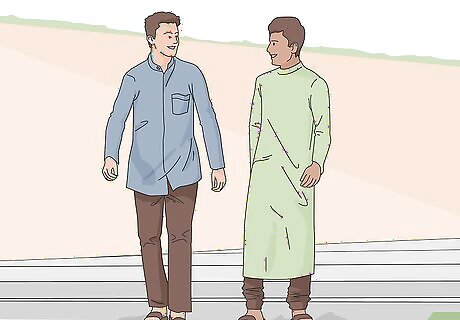
Take your premonastic vows after studying for 6 months to a year. As an initiate, study, attend the temple regularly, and become engaged as a member of the monastery’s community. After 6-12 months, you will be approved as a premonastic if the guru thinks you are worthy. Take the monastery’s vows to become a premonastic student. Initiates rarely live at the monastery they belong to. Premonastics may live at the monastery for a period of time, or they may be asked to move there permanently. The vows are going to be different depending on your particular order and brand of Hinduism. Typically, you will need to shave part of your head, abstain from meat or alcohol, become celibate, and continue to follow dharma.
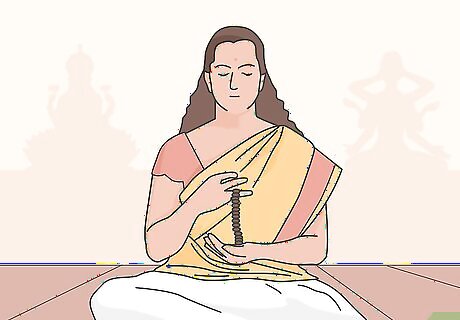
Complete your renewable vows after 6-24 months at the monastery. Continue to work, study, pray, and meditate at the temple. Continue to socialize and communicate with the other members of the community and attend every puja you can. Over the next 6-24 months, you will be allowed to take the renewable vows. Recite the vows in front of the guru to continue to show your commitment to the spiritual path. Volunteer for as many opportunities as you can to prove yourself to the guru and the other monks at the monastery.
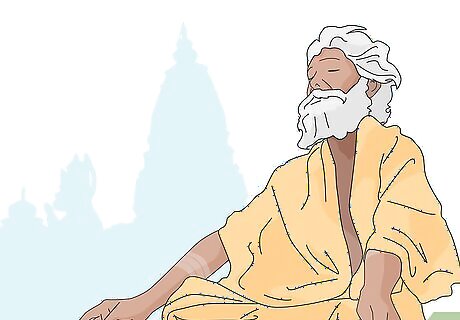
Take your lifetime vow to become a sanyāsī, sādhu, or swami. After you’ve taken your renewable vows repeatedly over the course of a few years, you will earn the right to take your lifetime vows and become a sanyāsī, sādhu, or swami—types of Hindu monks. Complete the lifetime vows in front of your new brothers and sisters and move to the monastery to live there permanently if you haven’t already. Follow the guru and do your best to continue growing in the community. A sanyāsī is a female monk, while a sādhu is a male monk. A swami is a male monk that works as a teacher. A yogi is a monk that has mastered the religious practice of yoga.




















Comments
0 comment